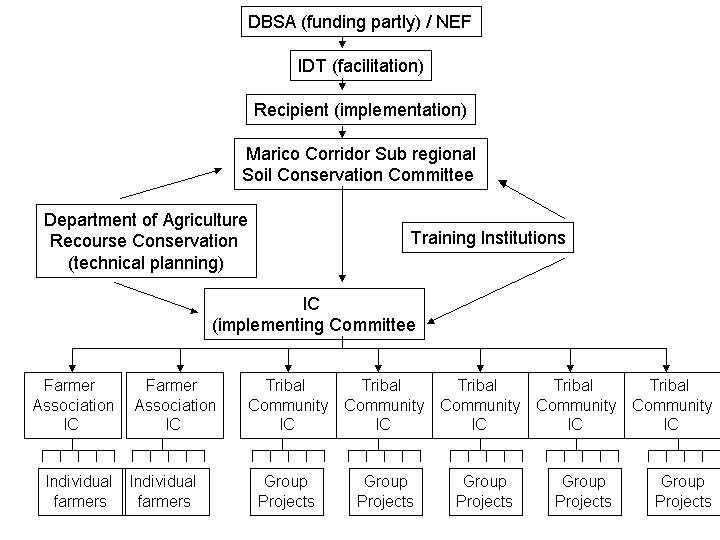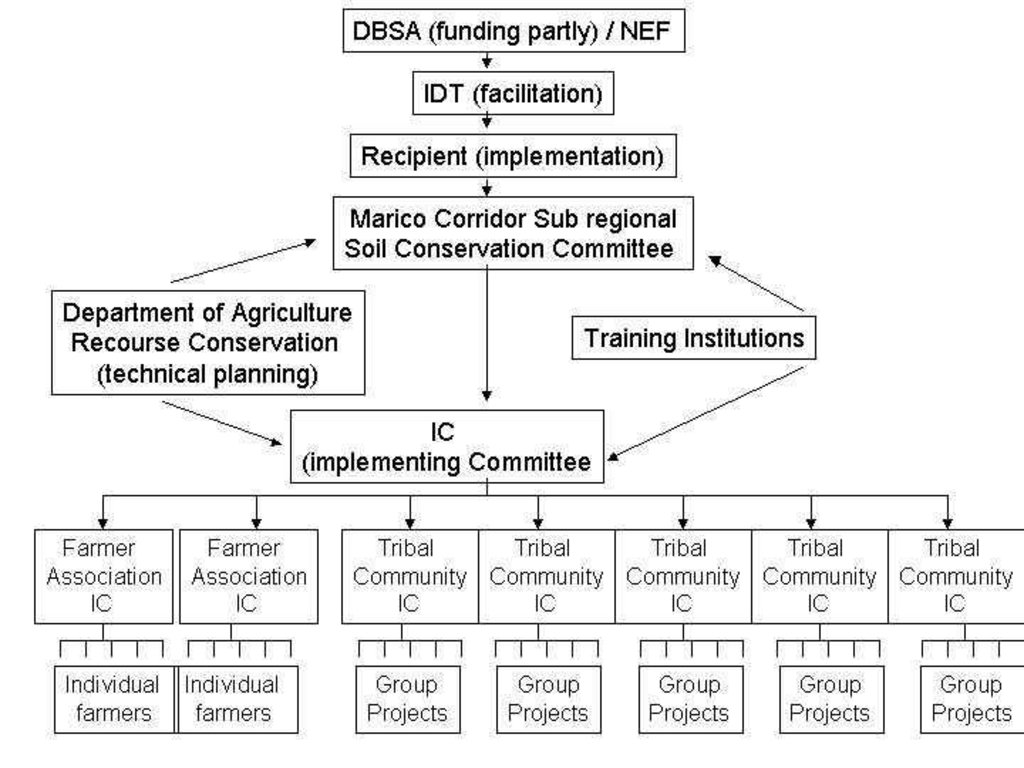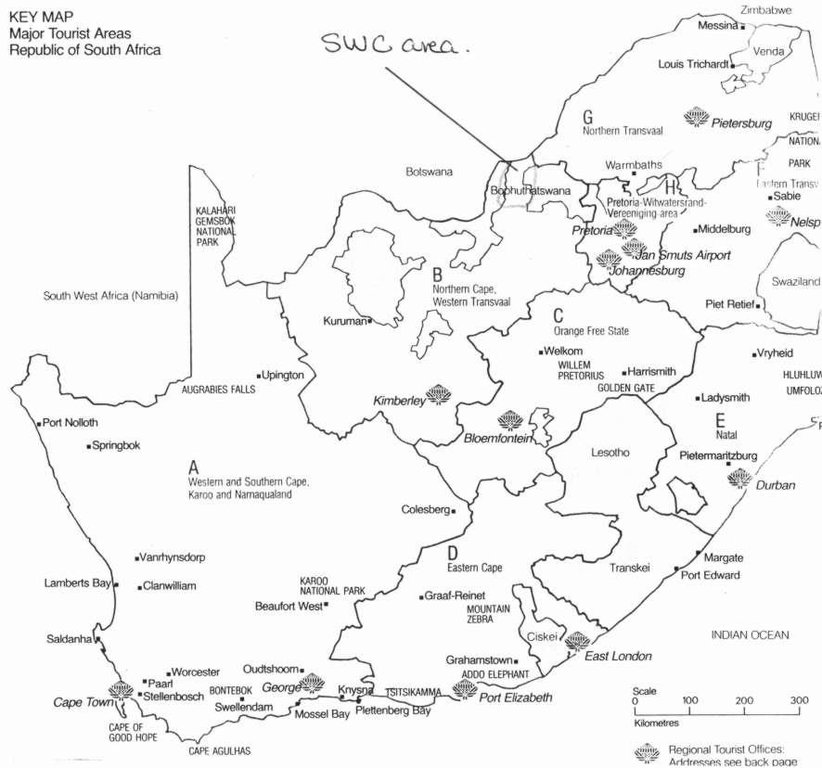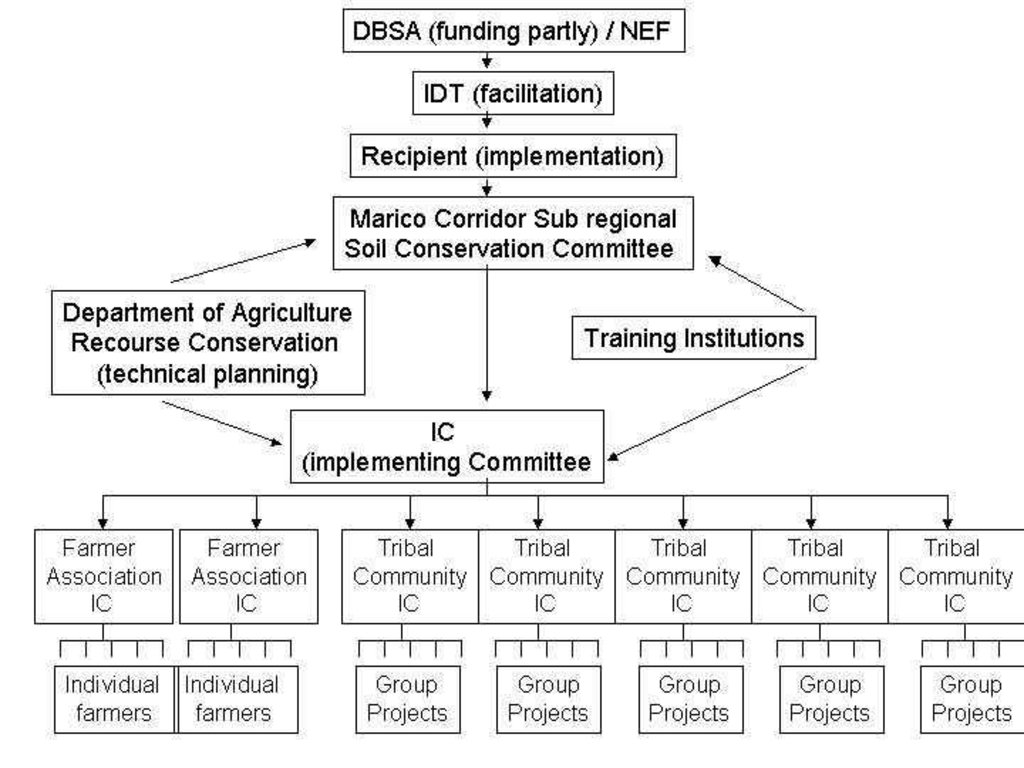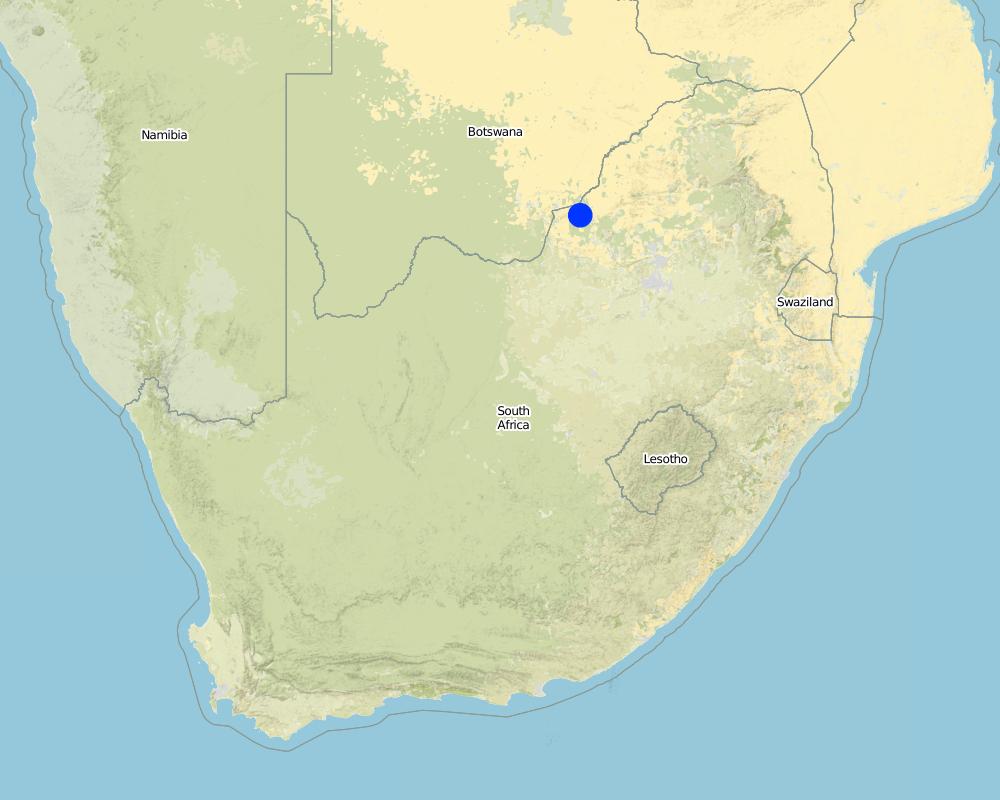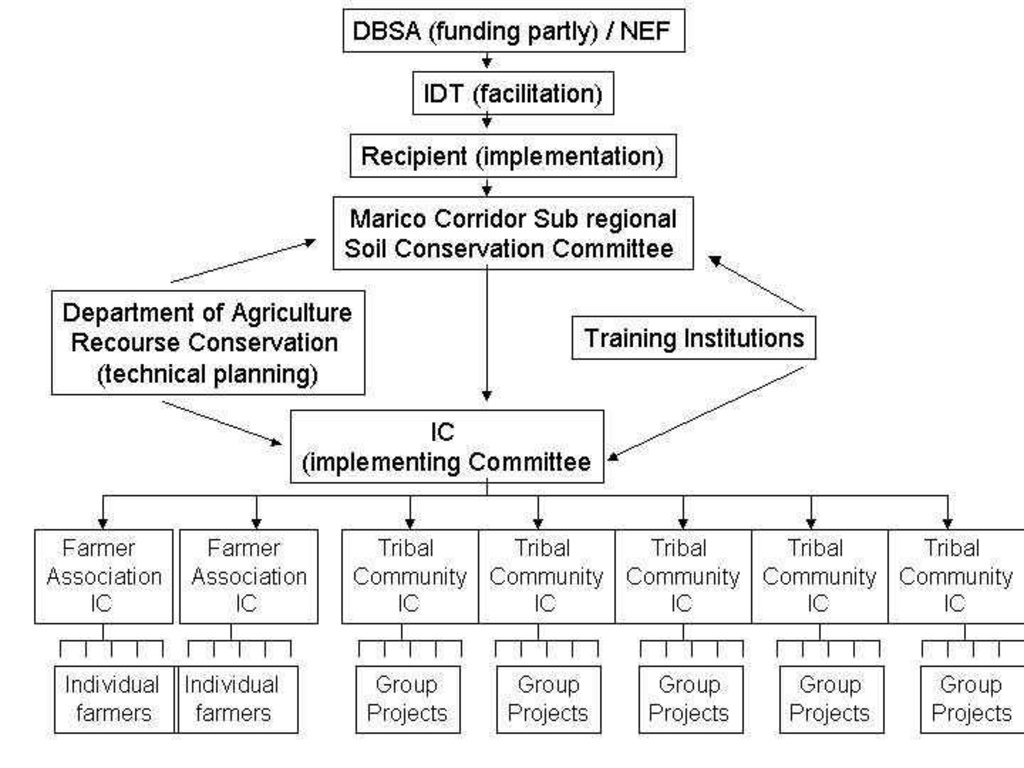Community driven Protection of the Molatedi Dam Catchment area [South Africa]
- Creation:
- Update:
- Compiler: Philippe Zahner
- Editor: –
- Reviewer: Fabian Ottiger
approaches_2345 - South Africa
View sections
Expand all Collapse all1. General information
1.2 Contact details of resource persons and institutions involved in the assessment and documentation of the Approach
Name of the institution(s) which facilitated the documentation/ evaluation of the Approach (if relevant)
Swiss Agency for Development and Cooperation (DEZA / COSUDE / DDC / SDC) - Switzerland1.3 Conditions regarding the use of data documented through WOCAT
The compiler and key resource person(s) accept the conditions regarding the use of data documented through WOCAT:
Yes
1.4 Reference(s) to Questionnaire(s) on SLM Technologies
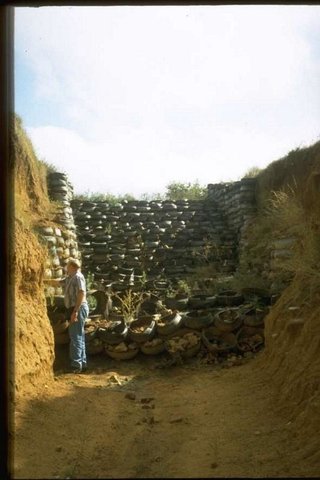
Gravity type inverted tyre structure [South Africa]
Stabilising of gully erosion by means of gravity type inverted tyre structures filled with stone.
- Compiler: Mirjam Staehli
2. Description of the SLM Approach
2.1 Short description of the Approach
Development and capacity building in participating communities through the implementation of measures to prevent topsoil losses through erosion in the Molatedi dam catchment area.
2.2 Detailed description of the Approach
Detailed description of the Approach:
Aims / objectives: Initiated by Welkom Farmers' Association through the Marico corridor sub-regional soil conservation committee. The aims were: 1) development and capacity building in participating communities and 2) implementation of measures to prevent topsoil losses through erosion in the Molatedi dam catchment area.
2.3 Photos of the Approach
2.5 Country/ region/ locations where the Approach has been applied
Country:
South Africa
Region/ State/ Province:
North West Province
Map
×2.6 Dates of initiation and termination of the Approach
Indicate year of initiation:
1994
Year of termination (if Approach is no longer applied):
1995
2.7 Type of Approach
- project/ programme based
2.8 Main aims/ objectives of the Approach
The Approach focused mainly on SLM with other activities (Development objective, Rehabilitation of the production potential of the land, Job creation component, Training component, Stabilising the catchment area of the Molatedi dam against erosion and excessive topsoil losses.)
Help the community, work together
The SLM Approach addressed the following problems: Unemployment. Lack of training. Erosion - loss of topsoil. Rehabilitation of natural resources
2.9 Conditions enabling or hindering implementation of the Technology/ Technologies applied under the Approach
availability/ access to financial resources and services
- hindering
Grant from D.B.S.A. Contribution by participating farmers associations
Treatment through the SLM Approach: farmers associations
legal framework (land tenure, land and water use rights)
- enabling
The existing land ownership, land use rights / water rights greatly helped the approach implementation: Hinder: great Private ownership helps implementation. Communal land - hindrance because no individual accepts responsibility
knowledge about SLM, access to technical support
- hindering
Treatment through the SLM Approach: Soil conservation technician and soil conservation committee support
other
- hindering
Knowledge
Treatment through the SLM Approach: Training
3. Participation and roles of stakeholders involved
3.1 Stakeholders involved in the Approach and their roles
- local land users/ local communities
Working land users were mainly women (Groups - divided slightly more women)
Every community involved in project through their participation in the implementing committee.
- local government
Soil conservation committee
- national government (planners, decision-makers)
Supported communities
IDT facilitation
If several stakeholders were involved, indicate lead agency:
Together - project description funding and execution.
3.2 Involvement of local land users/ local communities in the different phases of the Approach
| Involvement of local land users/ local communities | Specify who was involved and describe activities | |
|---|---|---|
| initiation/ motivation | interactive | public meetings; Monthly - special meetings as need arose |
| planning | interactive | public meetings; Monthly - special meetings as need arose |
| implementation | interactive | Mainly: responsibility for major steps; partly: responsibility for minor steps; Monthly - special meetings as need arose |
| monitoring/ evaluation | none | |
| Research | none |
3.3 Flow chart (if available)
3.4 Decision-making on the selection of SLM Technology/ Technologies
Specify who decided on the selection of the Technology/ Technologies to be implemented:
- mainly land users, supported by SLM specialists
Explain:
consultative.
Decisions on the method of implementing the SLM Technology were made by mainly by SLM specialists with consultation of land users. consultative.
4. Technical support, capacity building, and knowledge management
4.1 Capacity building/ training
Was training provided to land users/ other stakeholders?
Yes
Specify who was trained:
- land users
Form of training:
- on-the-job
- farmer-to-farmer
- demonstration areas
- courses
Subjects covered:
Description of training component
4.3 Institution strengthening (organizational development)
Have institutions been established or strengthened through the Approach?
- yes, greatly
Specify the level(s) at which institutions have been strengthened or established:
- local
Specify type of support:
- capacity building/ training
4.4 Monitoring and evaluation
Is monitoring and evaluation part of the Approach?
Yes
Comments:
bio-physical aspects were ad hoc monitored through observations
technical aspects were ad hoc monitored through observations
socio-cultural aspects were ad hoc monitored through observations
economic / production aspects were ad hoc monitored through observations
area treated aspects were ad hoc monitored through observations
no. of land users involved aspects were ad hoc monitored through observations
management of Approach aspects were ad hoc monitored through observations
There were few changes in the Approach as a result of monitoring and evaluation: Project period was only 6 months. Very strict procedures had to be followed in all events. E.g. wager sheets - full particulars of workers External audit concerning finances.
4.5 Research
Was research part of the Approach?
Yes
Specify topics:
- technology
Give further details and indicate who did the research:
Observation with everted tyre structure
Research was carried out on-farm
5. Financing and external material support
5.1 Annual budget for the SLM component of the Approach
If precise annual budget is not known, indicate range:
- 100,000-1,000,000
Comments (e.g. main sources of funding/ major donors):
Approach costs were met by the following donors: government (national - Development bank of RSA, NEF fund): 60.0%; local community / land user(s) (Commercial farmers): 40.0%
5.2 Financial/ material support provided to land users
Did land users receive financial/ material support for implementing the Technology/ Technologies?
Yes
5.3 Subsidies for specific inputs (including labour)
- equipment
| Specify which inputs were subsidised | To which extent | Specify subsidies |
|---|---|---|
| machinery | fully financed | |
| tools | fully financed | |
- other
| Other (specify) | To which extent | Specify subsidies |
|---|---|---|
| Training | fully financed |
If labour by land users was a substantial input, was it:
- paid in cash
5.4 Credit
Was credit provided under the Approach for SLM activities?
No
6. Impact analysis and concluding statements
6.1 Impacts of the Approach
Did the Approach help land users to implement and maintain SLM Technologies?
- No
- Yes, little
- Yes, moderately
- Yes, greatly
Lessons learnt from this project can be adapted and be implemented in new projects.
Did the Approach improve issues of land tenure/ user rights that hindered implementation of SLM Technologies?
- No
- Yes, little
- Yes, moderately
- Yes, greatly
The problem is unlikely to be overcome in the near future. Only if private ownership of land is propagated.
Did other land users / projects adopt the Approach?
- No
- Yes, little
- Yes, moderately
- Yes, greatly
6.3 Sustainability of Approach activities
Can the land users sustain what has been implemented through the Approach (without external support)?
- no
If no or uncertain, specify and comment:
No funding available
6.4 Strengths/ advantages of the Approach
| Strengths/ advantages/ opportunities in the land user’s view |
|---|
| Job creation (How to sustain/ enhance this strength: Project planning must be done carefully and job creation planned according to sustainability) |
| Improvement of natural resources (How to sustain/ enhance this strength: Plan additional new projects) |
| Strengths/ advantages/ opportunities in the compiler’s or other key resource person’s view |
|---|
| Project initiated by land users (bottom-up approach) (How to sustain/ enhance this strength: Necessary support from institutions (financial, technical - provide research, information, training etc.)) |
| Equal rights and participation for all participants (How to sustain/ enhance this strength: Ensure equal representing on a joint implementing committee) |
| Adequate technical assistance (How to sustain/ enhance this strength: Ensure that capable technicians are involved with planning and execution of project) |
| Adequate financial assistance (How to sustain/ enhance this strength: Budget to be draw-up by all specialists and land users) |
6.5 Weaknesses/ disadvantages of the Approach and ways of overcoming them
| Weaknesses/ disadvantages/ risks in the land user’s view | How can they be overcome? |
|---|---|
| Project was not long enough |
| Weaknesses/ disadvantages/ risks in the compiler’s or other key resource person’s view | How can they be overcome? |
|---|---|
| The budget was unbalanced and not drawn up with all stakeholders involved | Involve specialists and all the role players in the project |
| Payment of daily wages as opposed to paying for task executed well. | Develop contractors that is paid according to work done and productivity. |
| The budget was inadequate for material needed for conservation works | Draw up a budget with SWC specialists input to ensure funds for conservation works |
| The facilitator was not capable to do facilitation | Use well trained proven facilitator acceptable to participation communities |
7. References and links
7.1 Methods/ sources of information
- field visits, field surveys
- interviews with land users
Links and modules
Expand all Collapse allLinks

Gravity type inverted tyre structure [South Africa]
Stabilising of gully erosion by means of gravity type inverted tyre structures filled with stone.
- Compiler: Mirjam Staehli
Modules
No modules


